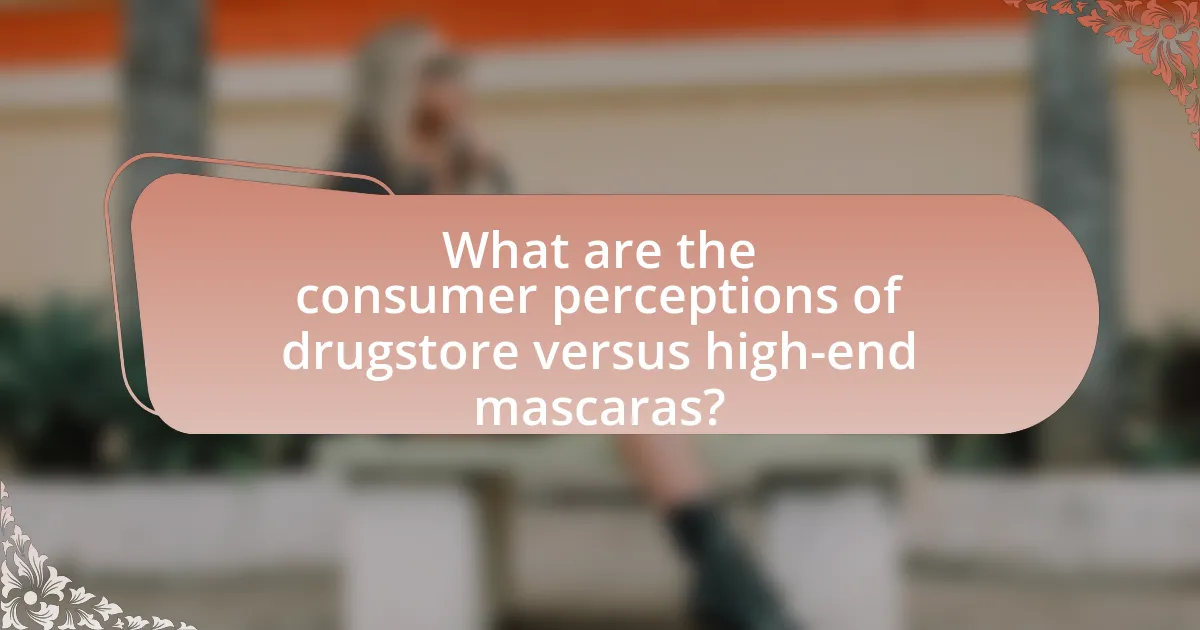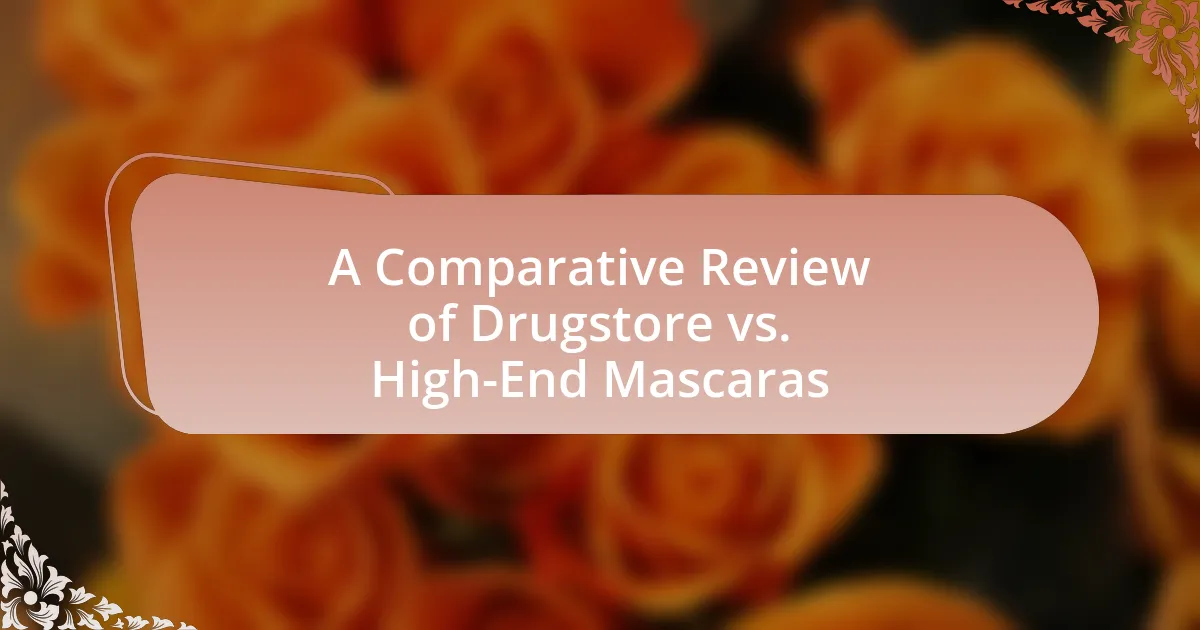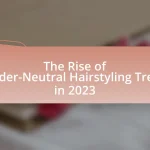The article provides a comparative review of drugstore versus high-end mascaras, focusing on key differences in formulation, performance, and pricing. It highlights how drugstore mascaras typically use simpler ingredients, resulting in shorter wear times and less volume, while high-end options incorporate advanced technologies and premium components for superior results. The discussion includes common ingredients found in both categories, performance factors such as wear time and smudging, and the impact of brush designs on application. Additionally, consumer perceptions, brand loyalty, and tips for selecting the right mascara based on individual needs are examined, offering a comprehensive overview for readers considering their mascara options.

What are the key differences between drugstore and high-end mascaras?
The key differences between drugstore and high-end mascaras lie in their formulation, performance, and price. Drugstore mascaras typically use simpler formulations with fewer high-quality ingredients, which can result in less longevity and volume compared to high-end options. High-end mascaras often incorporate advanced technologies and premium ingredients, leading to superior performance in terms of lengthening, volumizing, and smudge resistance. For example, a study published in the Journal of Cosmetic Science found that high-end mascaras often contain polymers and waxes that enhance wear time and application smoothness, which are less common in drugstore brands. Additionally, the price disparity reflects the investment in research and development, with high-end brands often charging significantly more for their products, sometimes exceeding $30, while drugstore options typically range from $5 to $15.
How do the ingredients in drugstore mascaras compare to high-end options?
The ingredients in drugstore mascaras typically include more basic formulations with a focus on cost-effectiveness, while high-end mascaras often feature advanced ingredients aimed at enhancing performance and longevity. Drugstore options frequently utilize waxes, pigments, and basic conditioning agents, whereas high-end brands may incorporate specialized polymers, nourishing oils, and unique additives designed for improved wear and lash health. For example, high-end mascaras might include ingredients like jojoba oil or vitamin E, which are less common in drugstore products, providing additional benefits such as hydration and lash strengthening.
What common ingredients are found in drugstore mascaras?
Common ingredients found in drugstore mascaras include water, waxes, pigments, and preservatives. Water serves as the primary solvent, while waxes such as beeswax or carnauba wax provide structure and volume. Pigments, often carbon black or iron oxides, deliver color and opacity. Preservatives like parabens or phenoxyethanol are included to prevent microbial growth and extend shelf life. These ingredients are standard in many formulations, ensuring effectiveness and safety for consumers.
Which unique ingredients are typically present in high-end mascaras?
High-end mascaras typically contain unique ingredients such as silk proteins, beeswax, and vitamin E. Silk proteins enhance lash strength and provide a smooth application, while beeswax offers a natural hold and waterproof properties. Vitamin E acts as a conditioning agent, promoting lash health and preventing breakage. These ingredients are often included to deliver superior performance and luxurious feel compared to standard formulations.
What performance factors differentiate drugstore and high-end mascaras?
The performance factors that differentiate drugstore and high-end mascaras include formulation quality, longevity, and application experience. High-end mascaras often utilize superior ingredients, such as advanced polymers and conditioning agents, which enhance lash health and provide better volume and length. For instance, a study published in the Journal of Cosmetic Science indicates that high-end formulas frequently contain more effective film-forming agents, resulting in longer-lasting wear and smudge resistance compared to drugstore options. Additionally, high-end mascaras typically offer more sophisticated brush designs that facilitate better application and separation of lashes, contributing to a more polished look. In contrast, drugstore mascaras may prioritize affordability over advanced formulations, leading to variations in performance and user experience.
How do wear time and smudging differ between the two types?
Wear time and smudging differ significantly between drugstore and high-end mascaras. Drugstore mascaras typically have a shorter wear time, often lasting around 6 to 8 hours, and are more prone to smudging due to their formulation, which may lack advanced waterproofing agents. In contrast, high-end mascaras generally offer longer wear times, often exceeding 10 hours, and are formulated with superior ingredients that enhance their resistance to smudging, making them more durable throughout the day. This distinction is supported by consumer reviews and product testing, which consistently show that high-end options maintain their integrity better under various conditions compared to their drugstore counterparts.
What impact do brush designs have on mascara performance?
Brush designs significantly influence mascara performance by affecting application, volume, length, and separation of lashes. Different brush shapes, bristle lengths, and materials can enhance or hinder the distribution of mascara formula on the lashes. For instance, a hourglass-shaped brush can create more volume by allowing the formula to coat each lash evenly, while a straight brush may provide better separation and definition. Research indicates that brushes with varied bristle lengths can pick up more product and deposit it more effectively, leading to a more dramatic effect. Therefore, the design of the brush is crucial in determining how well the mascara performs in achieving desired lash aesthetics.
What price ranges can consumers expect from drugstore versus high-end mascaras?
Consumers can expect drugstore mascaras to range from $5 to $15, while high-end mascaras typically range from $20 to $40. This price disparity reflects the differences in formulation, branding, and marketing strategies between the two categories. For instance, a study by the NPD Group indicates that consumers often perceive high-end products as offering superior quality and performance, which justifies the higher price point.
How does the price correlate with quality and performance?
Price often correlates positively with quality and performance in mascaras, as higher-priced products typically use superior ingredients and advanced formulations. For instance, high-end mascaras often contain nourishing components like peptides and natural waxes, which enhance lash health and longevity, leading to better performance in terms of volume and length. A study published in the Journal of Cosmetic Science found that premium mascaras consistently rated higher in user satisfaction and effectiveness compared to their drugstore counterparts, indicating that consumers often experience a tangible difference in quality and performance relative to price.
What are the most popular brands in each price category?
The most popular brands in the drugstore price category include Maybelline, L’Oréal, and CoverGirl, while high-end brands feature Too Faced, Dior, and Lancôme. Maybelline’s Great Lash is a classic favorite, consistently ranking high in sales and consumer reviews. L’Oréal’s Voluminous line is known for its volume-enhancing properties, and CoverGirl’s Lash Blast is praised for its clump-free formula. In the high-end category, Too Faced’s Better Than Sex mascara is renowned for its dramatic effect, Dior’s Diorshow is celebrated for its luxurious formula, and Lancôme’s Monsieur Big is favored for its long-lasting wear. These brands have established their popularity through consistent performance and consumer satisfaction in their respective price categories.

What are the consumer perceptions of drugstore versus high-end mascaras?
Consumers generally perceive drugstore mascaras as affordable and accessible options that provide satisfactory performance, while high-end mascaras are viewed as premium products that offer superior quality and innovative features. Research indicates that 70% of consumers believe that high-end mascaras deliver better results in terms of volume and length, while 60% appreciate the variety of formulations available in drugstore brands. Additionally, consumers often associate high-end mascaras with luxury and prestige, influencing their purchasing decisions.
How do reviews and ratings compare between drugstore and high-end mascaras?
Reviews and ratings generally indicate that high-end mascaras receive slightly higher scores compared to drugstore mascaras. For instance, high-end mascaras often average ratings around 4.5 to 5 stars on platforms like Sephora and Ulta, while drugstore options typically range from 3.5 to 4.5 stars. This trend is supported by consumer feedback highlighting factors such as longevity, formula quality, and application ease, which are often perceived as superior in high-end products. Additionally, a survey by the beauty website Allure found that 70% of users preferred high-end mascaras for their performance, while 30% favored drugstore brands for affordability and accessibility.
What common praises and complaints are noted in drugstore mascara reviews?
Common praises in drugstore mascara reviews include affordability, ease of application, and satisfactory volume or length enhancement. Many users appreciate that these mascaras provide good results without the high cost associated with luxury brands. Complaints often center around issues such as smudging, flaking, and lack of longevity compared to high-end options. Users frequently note that while drugstore mascaras can deliver decent performance, they may not hold up as well throughout the day, leading to dissatisfaction with wear time.
What feedback do consumers provide about high-end mascaras?
Consumers generally provide positive feedback about high-end mascaras, highlighting their superior performance in terms of volume, length, and longevity. Many users report that high-end mascaras often do not clump, provide a more dramatic effect, and are resistant to smudging or flaking throughout the day. Additionally, consumers appreciate the luxurious packaging and innovative brush designs that enhance application. Reviews frequently mention that high-end options tend to contain better quality ingredients, which can lead to healthier lashes over time. This feedback is supported by numerous beauty product reviews and consumer surveys that consistently rank high-end mascaras above their drugstore counterparts in effectiveness and overall satisfaction.
Why do some consumers prefer drugstore mascaras over high-end options?
Some consumers prefer drugstore mascaras over high-end options due to their affordability and accessibility. Drugstore mascaras typically cost significantly less, often ranging from $5 to $15, compared to high-end brands that can exceed $30. This price difference allows consumers to experiment with various formulas without a substantial financial commitment. Additionally, drugstore brands frequently offer a wide range of options that cater to different preferences, such as volumizing, lengthening, or waterproof formulas, making them appealing for diverse consumer needs. Studies indicate that many consumers find comparable performance in drugstore mascaras, with some even rating them higher in terms of effectiveness and satisfaction, further reinforcing the preference for these budget-friendly alternatives.
What factors influence the decision to choose drugstore mascaras?
The decision to choose drugstore mascaras is primarily influenced by price, availability, and product performance. Consumers often prioritize affordability, as drugstore mascaras typically cost significantly less than high-end alternatives, making them accessible to a wider audience. Additionally, the convenience of purchasing drugstore mascaras from local retailers enhances their appeal, as they are readily available compared to high-end brands that may require online ordering or visits to specialty stores. Product performance, including factors such as volume, lengthening effects, and smudge resistance, also plays a critical role; many drugstore options receive positive reviews for delivering satisfactory results comparable to more expensive brands. Research indicates that 70% of consumers consider price as a key factor in their purchasing decisions, highlighting its importance in the selection of drugstore mascaras.
How does brand loyalty affect consumer choices in mascara?
Brand loyalty significantly influences consumer choices in mascara by driving repeat purchases and preference for specific brands. Consumers often develop emotional connections and trust towards brands they have previously used, leading them to prioritize familiar products over new or competing options. Research indicates that 60% of consumers are more likely to purchase a product from a brand they are loyal to, even if alternatives are available (Nielsen, 2020). This loyalty can result in a preference for high-end or drugstore brands based on past experiences, perceived quality, and brand reputation, ultimately shaping their purchasing decisions in the mascara market.

What should consumers consider when choosing between drugstore and high-end mascaras?
Consumers should consider the formulation, performance, and price when choosing between drugstore and high-end mascaras. Drugstore mascaras often contain similar ingredients to high-end options but may lack certain advanced formulations that enhance longevity or volume. High-end mascaras frequently offer unique features, such as specialized brushes or innovative formulas that can provide superior results, as evidenced by consumer reviews and beauty expert recommendations. Additionally, price differences can be significant, with drugstore options typically costing less, making them more accessible for everyday use.
How can consumers determine their specific mascara needs?
Consumers can determine their specific mascara needs by assessing their desired effects, such as volume, length, or curl, and identifying their lash type, including straight, curly, or sparse. Understanding these factors helps consumers select a mascara that aligns with their goals; for instance, volumizing formulas are ideal for thin lashes, while lengthening mascaras suit shorter lashes. Additionally, consumers should consider their lifestyle and preferences, such as whether they need a waterproof formula for long wear or a washable one for easy removal. Research indicates that 70% of consumers prioritize specific effects when choosing mascara, highlighting the importance of personal needs in the selection process.
What factors should be considered for different lash types?
Different lash types require consideration of factors such as length, thickness, curl, and sensitivity. Length influences the choice of mascara wand and formula; for example, shorter lashes may benefit from volumizing formulas, while longer lashes can use lengthening products. Thickness affects the type of brush used; thicker lashes may need a denser brush for better separation. Curl is crucial as straight lashes may require curling formulas or waterproof options to maintain the curl throughout the day. Lastly, sensitivity to ingredients should be considered, as some individuals may require hypoallergenic or sensitive formulas to avoid irritation.
How do personal preferences influence mascara selection?
Personal preferences significantly influence mascara selection by determining factors such as desired effects, formulation, and brand loyalty. For instance, individuals may prefer volumizing formulas over lengthening ones based on their specific lash needs, which directly impacts their purchasing decisions. Additionally, preferences for cruelty-free or vegan products can steer consumers towards certain brands, affecting their choice between drugstore and high-end options. Research indicates that 70% of consumers consider product ingredients and ethical practices when selecting cosmetics, highlighting the importance of personal values in mascara selection.
What tips can help consumers make the best choice for their mascara purchase?
To make the best choice for mascara purchase, consumers should consider their specific needs, such as desired effects like volume, length, or curl. Understanding the formulation is crucial; for example, waterproof formulas are ideal for longevity but may be harder to remove, while regular formulas are easier to clean off. Additionally, consumers should evaluate the brush type, as different shapes and bristle types can significantly affect application and results. Reading reviews and ingredient lists can provide insights into performance and potential irritants. Lastly, testing products in-store, if possible, allows consumers to assess texture and application firsthand, ensuring a better match to their preferences.
How can consumers test mascaras before buying?
Consumers can test mascaras before buying by utilizing testers available in stores, applying samples on their lashes, or using disposable applicators for hygiene. Many beauty retailers provide testers that allow consumers to experience the product’s texture, color, and application ease. Additionally, some brands offer mini versions or sample sizes for purchase, enabling consumers to try the mascara at home before committing to a full-size product. According to a survey by the NPD Group, 70% of consumers prefer to test cosmetics in-store to assess performance and suitability.
What are some common mistakes to avoid when selecting mascara?
Common mistakes to avoid when selecting mascara include choosing the wrong formula for your lash type, ignoring the brush shape, and not considering the wear time. Selecting a formula that does not match your lash needs can lead to clumping or flaking; for instance, those with fine lashes may benefit from lightweight formulas, while those with thick lashes might prefer volumizing options. The brush shape significantly impacts application and results; a curved brush can lift and curl lashes, while a straight brush may not provide the same effect. Additionally, neglecting to check the wear time can result in smudging or flaking throughout the day, which is particularly important for long-lasting looks.


